Compost is one of the best soil additives for a vegetable garden. It is also one of the least expensive. Composting turns garden and kitchen waste materials into a rich, organic amendment.
The combination of dead vegetation with air and moisture will result in compost. Composting is a natural decomposition. Composting can take place in a simple free-standing heap of garden waste or a homemade wire-mesh container or a commercially made bin.
The main components of compost are lawn clippings, vegetable refuse, straw, leaves, and animal manure. When making compost, it is often necessary to add some organic nitrogen fertilizer to aid the decomposition process; this is especially true if your compost ingredients include lots of autumn leaves.

About compost
Compost is the decomposed remains of organic materials-including leaves, kitchen scraps, and plant remains. Compost contains essentially all the major and minor nutrients plants need to thrive and improves soil structure—the home where plants live.
You cannot add too much compost to your vegetable garden—all of the compost you add will improve crop yield. If possible, spread an inch of compost across planting beds in early spring and again after harvest. If you can spread two inches of compost across the planting area, even better! As well, throw a handful of compost into planting holes at transplant time and later add compost around crops during the growing season as a side-dressing for an extra dose of nutrients.
The best compost is aged compost; it will be blackish brown in color, moist, crumbly, and uniform in texture; the vegetable matter in aged compost will not be recognizable. The nutrients in aged compost—often called humus—will be the most accessible to plant roots. (Leaf transpiration draws the nutrients in humus that has been dissolved in soil moisture into plant roots and up into plant cells to fuel plant growth.) Partially decomposed compost benefits the soil as well; it feeds earthworms and soil bacteria that exude plant nutrients as well
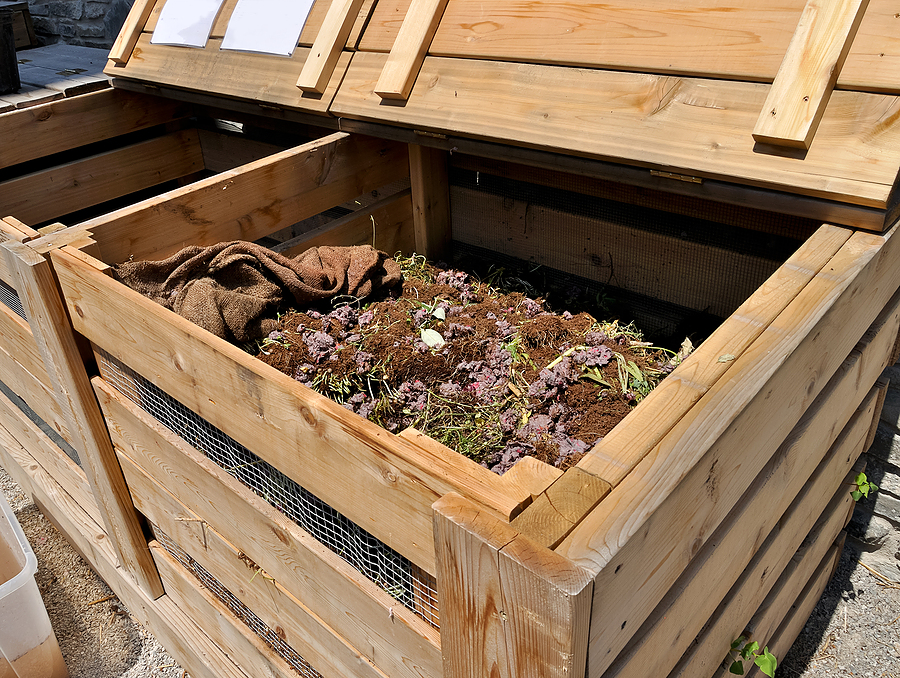
Composting methods
There are two ways to make compost: aerobic composting allows air to accelerate decomposition; anaerobic composting all but excludes air.
Anaerobic composting
Anaerobic composting can be done simply by piling up garden and kitchen waste as it accumulates into one big pile or building a compost pile one layer at a time—alternating brown and green waste. Layering is the most effective way of anaerobic composting. Layers should alternate between woody, carbon-rich material (browns), and lush, leafy nitrogen-rich material (greens). An optimal layer would be about 6 inches deep; the optimal compost pile would be 3 to 4 feet high and wide. Organic material can simply be piled up or held in a box or cage, lightly sprinkled with water, then covered with a tarp or heavy-duty plastic sheet, and left to rot. Complete decomposition will occur in 9 months to a year depending upon the weather. (Solar heat will accelerate decomposition.)
Aerobic composting
Aerobic composting is accomplished via rapid decomposition. Follow the same layer and compost pile formula used in anaerobic composting, but rather than walking away and allowing time to take its course, aerobic composting calls for turning the compost. Turning introduces fresh oxygen into the pile which re-activates the composting process by giving bacteria renewed energy to decompose organic materials. Aerobic composters seek to keep the center of the compost pile at about 140°-158°F, optimal for decomposition. When the temperature falls below optimal (as measured by a compost thermometer), the pile is turned—as often as once a week. You can turn a compost pile by forking materials on the outside of the pile to the center or by breaking down the pile and rebuilding it layer by layer.
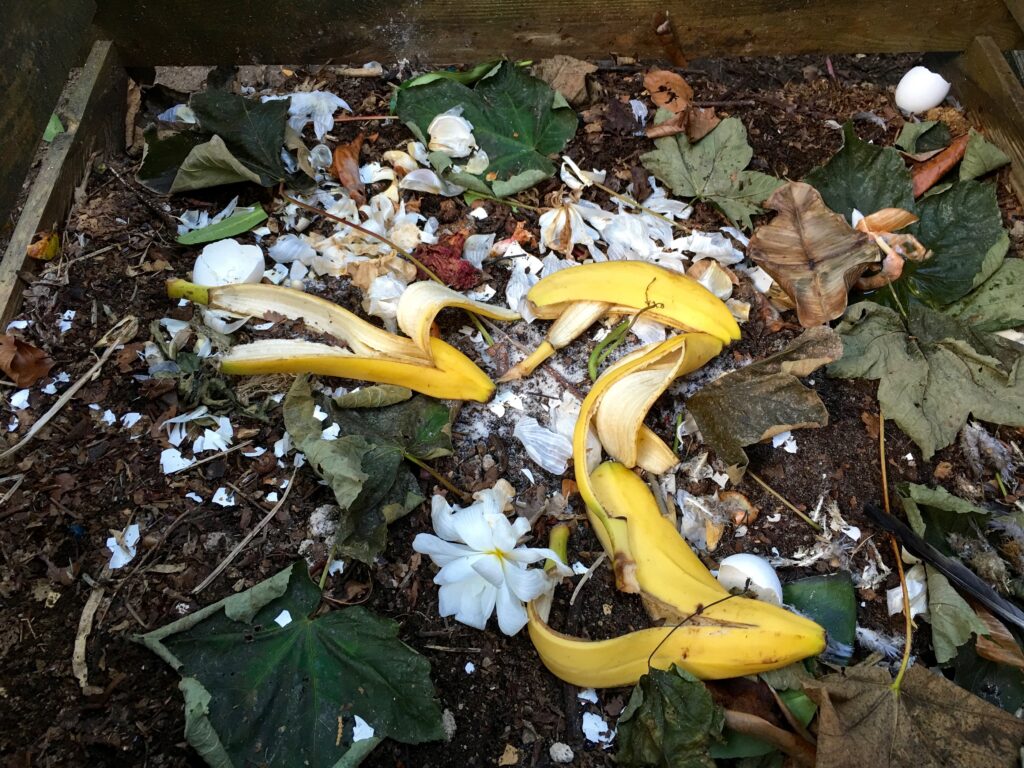
What to compost
Compost is best made from garden cuttings and kitchen peelings and scraps, including fruit scraps, vegetable scraps, coffee grounds, stale bread, and eggshells. Do not use meat, bones, or fat, including dairy products in compost piles—these materials will not decompose quickly and will attract insects and vermin.
Keep the compost pile just moist; do not allow it to dry out. Aim for about 50 percent greens (grass cuttings and fruit and vegetable scraps) and about 50 percent browns (dry leaves and twigs, egg boxes, and cardboard). If the compost turns wet and sludgy, add more browns, if it is too dry, add more greens.
Home composting basics
Here are the basics you’ll need to know to start composting at home:
• Site the compost bin or pile near the vegetable garden and kitchen close to where the finished compost will be used or locate the pile in an area of the garden where you will plant next year
• Choose a site in full sun or light shade sheltered from the wind.
• Place the compost bin or pile on bare soil so that excess water can drain away. Till or dig the soil underneath before you begin to fill the area. This will assist drainage and allow macroorganisms such as worms to enter the pile.
• Place the bin or pile with ample air circulation on all sides.
• A compost bin can be square or round. It can be made out of lumber, chicken wire, hardware cloth, concrete blocks, or bales of hay. You can use a wooden box leaving space between the sideboards. (Do not use pressure-treated wood or wood treated with toxic preservatives.) You can use four wood frames covered with chicken wire and latched together to form a cube. You can use galvanized metal mesh or welded wire shaped like a cylinder and staked in place. You can use bricks omitting a few bricks on each side for aeration. You can use a steel drum with hundreds of large holes punched in the side so that the external surface is about half and half holes to solid matter.
• If you make one side of the bin removable you will have easier access to the refuse material you are composting. Leave as much open air space to the outside as solid material used to enclose the compost pile. Line the bin with ¼- to ½-inch mesh or hardware cloth if you are worried about compost falling out.
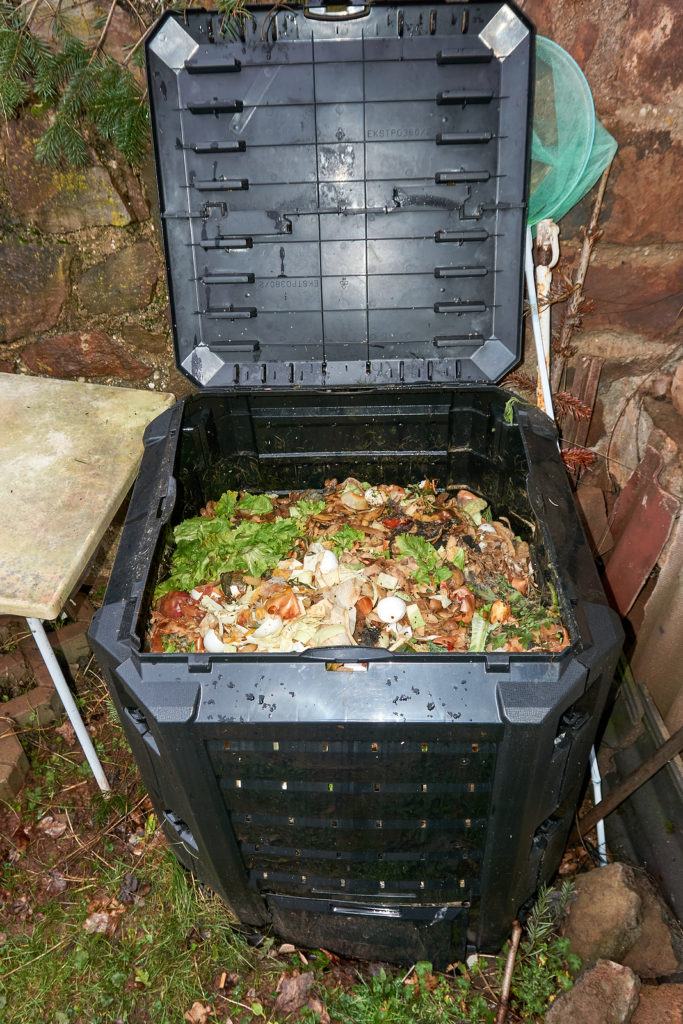
• Use a commercial wood, wire, or plastic bin for aesthetic reasons. Commercial bins are not likely to speed up the composting process but they look good. Most commercial bins are specially designed to allow the compost to be extracted from the bottom of the bin without disturbing the rotting compost at the top. If you choose a rotating or tumbling bin, be sure it is easy to turn when full; wet compost is very heavy.
• You can use a double or triple bin system: one bin to hold new refuse, a second bin to hold partially decomposed material, and a third to hold finished compost. In this system, composting material is forked from one bin to the next as composting progress.
• If you do not use a transfer system, you can turn a single pile or bin with a garden fork. Fork the material on the outside of the pile to the inside and the inside material to the outside to speed up composting. (The real composting takes place at the center of the pile.)
• A free-standing compost pile is just as effective as a bin. Situate the free-standing pile on a level, well-draining soil, or compost in a trench or pit in the garden. Gently slope the pile upwards as you add material.
• A compost bin or free-standing pile should be a minimum of 3 feet in each dimension; 4 feet in each dimension is better, and 5 feet in each dimension is best. Composting is accomplished most quickly when the pile runs “hot,” when the ingredients of the pile, moisture, air, and the microorganisms in the pile combine to heat the interior of the pile to 130°F or more. (The heat is generated by the work of living microorganisms. Large piles heat more quickly; this is called “hot” composting.) A smaller, cooler, or “cold” compost pile will still produce finished compost, but the process takes more time.
• Start the pile with a fibrous material on the bottom: shredded leaves, straw, hay, corn husks, or the like. On top of the first layer place an inch or two of garden soil or cow or horse manure. Then begin adding the second layer of compostable organic material; almost anything that was once alive can be composted. From the kitchen, you can compost carrot and other vegetable shavings, fruit peels, citrus pulp and rinds, cooked and uncooked vegetables, corn cobs, stale bread, eggshells, coffee grounds, tea bags, and shredded newspaper. From the garden, you can compost fresh and dried leaves, prunings and hedge trimmings, weeds without seeds, nutshells, grass clippings, dead plants, sawdust, wood chips, and cow and horse manure.
• Almost anything organic except animal remains can be composted. Do not compost high-protein items such as meat, poultry, fish, grease and fat, dairy products, or dog or cat litter. These will attract scavengers–mice and vermin, dogs, cats, and raccoons. (If animals get into the compost pile, enclose it with fine mesh fencing.) And don’t compost diseased or insect-infested plants, weeds that have gone to seed, poisonous plants, toxic chemicals, or chemical fertilizers.
• Add to the pile a layer at a time; add 9 to 12 inches of waste and top each layer with 2 inches of soil or fresh manure (these contain more microorganisms). Tamp down each layer and give it a light soaking before adding the next layer. Repeat these layers until the bin is full–to about 4 or 5 feet high. Layering mixes different types of refuse and allows air to circulate through the compost.
• The ideal compost pile will contain both brown and yellow dry, coarse refuse such as dried leaves, straw, and small wood chips and green refuse such as grass clipping, fresh leaves, and kitchen scraps. Brown carbon-rich refuse supplies energy to decomposers working in the pile–mostly microorganisms such as bacteria, fungi, and yeasts, and larger organisms such as worms and insects. Green nitrogen-rich refuse provides protein to decomposers which allows them to grow and divide. Roughly equal parts browns and greens will speed composting.
• Keep the pile moist but not wet; this will aid decomposition. Moisten the pile with water every 2 weeks making sure it does not go dry. Make the top of the compost pile slightly concave so that water can penetrate.
• After several weeks, the pile will have shrunk to one-third of its original size. After this turn the pile every 6 weeks to that the rotted material on the inside will be on the outside and the material on the outside will be inside where it can decompose more quickly. Turning the pile moves material on the outside to the hot center. If you use two compost bins, transfer the contents to a second bin mixing the contents thoroughly. (Turning a compost pile is not required but unturned materials can take a year or more to decompose.)
• Cover the bin with a tarp or plastic lid so that rain does not soak the pile and slow composting. (The pile should be moist, not wet.)
• Materials are added to the top of the bin or pile and compost is removed from the bottom. Air should be able to penetrate the bin to allow microorganisms such as bacteria and fungi to thrive and help accomplish the composting.
• Compost is ready to use when the starting materials have decomposed beyond recognition and become deep brown or black colored and crumbly textured. This process can take 3 to 6 months; quicker in warm weather, and slower in cool weather.
• Finished compost is good for the garden; it both builds and feeds the soil. Spread your compost as a garden mulch topdressing 2 ½ gallons of compost to each square yard of the garden.
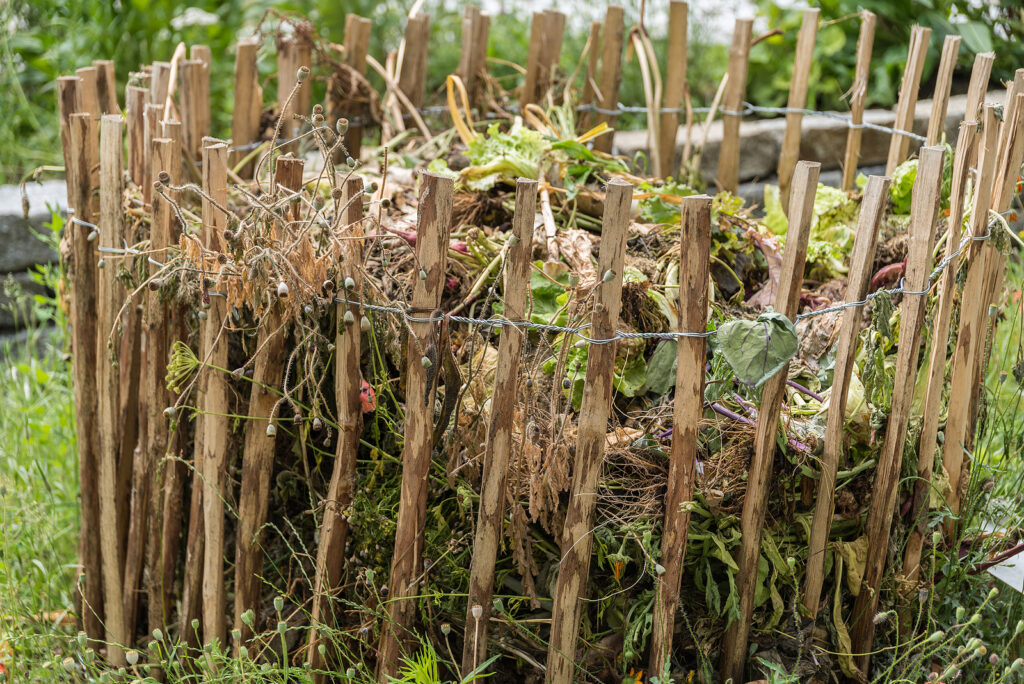
How to make compost in 15 easy steps
- Construct a pile 3 to 4 feet (1-1.2m) high. A pile this size will hold the heat to promote decomposition while allowing sufficient air to enter the pile and minimize odor. A compost pile can be simply made with a cylinder of welded construction wire or four wood frames covered with chicken wire and nailed or latched together to form a cube; you can also use four panels of construction-grade wire mesh attached to 4 x 4-inch posts. A classic compost setup has three bins or sections: one to hold new material, a second bin for partially decomposed material, and a third bin for finished compost. Material can be forked from one bin to the next as composting progresses or a full bin can be allowed to decompose and the second and third bin started as the one before fills up.
- Locate your compost pile in a shady, flat, well-drained place. Till or dig the soil underneath the pile before you begin composting; this will allow for drainage and worms to enter the pile from the soil below.
- Spread the first layer of plant debris (leaves, weeds, or grass clippings) 6 to 8 inches (15-20cm) deep on the ground or in the bin.
- Add a 1-to-2-inch (2.5-5cm) layer of aged steer or chicken manure or a few handfuls of nitrogen-rich fertilizer atop the plant debris. Then sprinkle topsoil atop that layer.
- Now you can add kitchen scraps (but not meat, fat, bones, or dairy products which can attract wasps and rodents).
- Continue to add layers of one material at a time.
- Chop or grind large materials such as plant stems or branches into small pieces. Mix coarse material with finer material such as grass clippings.
- You can add weeds, but not weeds that have flowered. Avoid adding weed seeds.
- Keep the compost moist but not soggy. The compost should never be wetter than a squeezed-out sponge. Cover the pile with a plastic sheet or tarp during heavy rainfall.
- Turn the pile every 3 to 4 weeks to discourage odor and flies and to help the compost to decompose evenly. You can use a compost thermometer to monitor the temperature inside the compost pile. The internal heat should reach 140° to 150°F (60°-65°C).
- Add small amounts of nitrogen, such as fresh manure, blood meal, or commercial organic nitrogen fertilizer, as each new layer is added. This will help keep the decomposition process going.
- Make the top of the compost pile slightly concave so that water can penetrate. If there has been no rain, water the compost every 7 to 10 days. This will aid decomposition.
- Speed up the process of decomposition by adding a few handfuls of fresh topsoil each time you add a layer of new organic matter. Topsoil is rich in microorganisms which speed the decomposing process.
- A mix of 50 to 60 percent by volume and weight of “brown” ingredients (straw, dry leaves) and 50 to 60 percent “green” ingredients (kitchen waste, grass clippings) fosters a faster-acting composting process.
- Compost is ready to use in the garden when it is crumbly and the starting materials have decomposed beyond recognition. This usually takes 1 to 3 months; faster when the weather is warm, and slower when the weather is cool or cold.
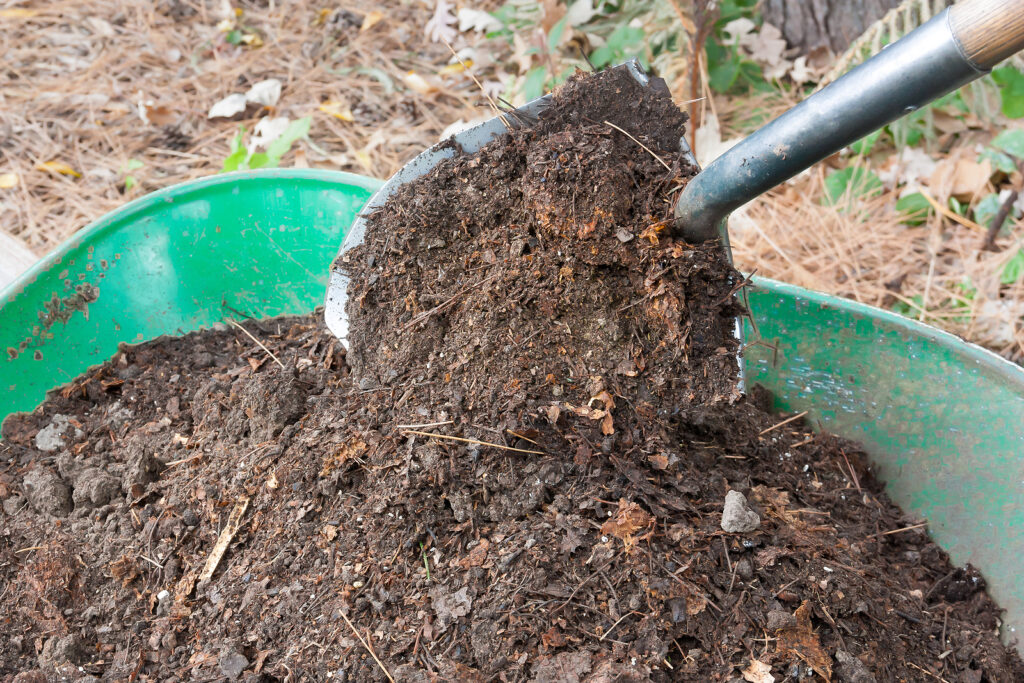
How to speed up the composting process
Composting turns garden and kitchen waste into humus. Humus is Nature’s best fertilizer and soil conditioner. The process of decomposition that we call composting happens in nature as billions of microorganisms feed, grow, reproduce, and die as they recycle kitchen and garden waste.
Compost will happen gradually over time. Set a pile of leaves or grass clippings in the corner of the yard and come back in a year: compost, perhaps humus. When you build a compost pile or use a commercial bin, you can speed things up. What Mother Nature will do on her own in a year’s time you can help her do more quickly.
Compost is partially decomposed organic matter. Humus is fully decomposed compost. Humus is the composter’s objective.
There are three types of composting: cold, slow, or passive composting; hot, fast, or active composting; and sheet compositing.
Sheet composting simply involves spreading undecomposed organic materials over the soil’s surface, then working them into the soil to decompose.
Cold, slow, or passive composting involves piling organic matter into a heap and letting Nature take its course. Little or no turning is involved and composting will occur in time. In cool temperatures, passive composting can take more than a year.
Hot, fast, or active composting requires that the compost pile be turned or aerated and that some attention be paid to the ratio of high-carbon materials–such as dry leaves, straw or steer manure–and high-nitrogen materials–such as fresh grass clippings, green prunings, and kitchen peelings. (An ideal ratio of carbon to nitrogen for hot composting is about 25:1.)
To speed along the work of your compost pile follow these suggestions:
- Set a foundation of plant debris (leaves, weeds, or grass clippings) 6 to 8 inches deep on the ground or in the bin. Add a 1 to 2-inch layer of soil, fresh cow or horse manure, or a few handfuls of blood meal, and then lay the first layer of ingredients for composting.
- Mix “brown” ingredients–such as straw and dry leaves–with “green” ingredients–such as grass clipping and kitchen waste.
- Chop or grind large materials such as plant stems into small pieces. Mix coarse material with finer material such as grass clippings.
- Keep the compost pile moist, but not wet. Compost should never be wetter than a squeezed-out sponge. Cover the pile with a plastic sheet or tarp during heavy rainfall.
- Turn the pile every 3 to 4 weeks to introduce oxygen into the pile and allow the contents to decompose evenly. (This will also discourage odor and flies.)
- Add a 1 to 2-inch layer of nitrogen-rich topsoil (rich in microorganisms and earthworms) or fresh manure or blood meal between each deeper layer of “brown” or “green” ingredients. This will speed decomposition.
- For significant decomposition to occur within the compost pile the heat within the pile must reach 140º to 150ºF. For this to happen, the air temperature surrounding the compost heap must be greater than 50ºF.
Compost bin how-to-build illustration
The illustration at the top shows how you can build a compost bin, and you can use the top third of this illustration to build a cold frame. A compost bin should be at least 3 x 3 x 3 feet—this will ensure a compost pile with enough mass to generate the heat needed to decompose the greens and browns you throw in. The flip-open top can be solid or slats to keep rain from soaking the contents. If you use the top third of the illustration to build a cold frame, the flip-open top can be framed with plexiglass or a double layer of clear plastic sheeting stretched across the lid. Cedar is the best choice; it will resist rotting for many years. Just cut the front, back, and pieces to equal lengths—whatever you decide. Use galvanized hinges and deck screws to put it all together.

Related articles of interest:
Earthworms and Soil Microorganisms
Improving Garden Soil with Organic Amendments
Vegetable Plant Nutrients: Sources and Deficiencies















